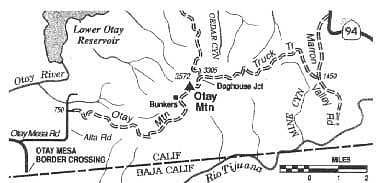 Facebook
Facebook
 X
X
 Instagram
Instagram
 TikTok
TikTok
 Youtube
Youtube
Rising like a rumpled pillow from the eastern extremity of Otay Mesa, Otay Mountain offers unparalleled, integrated views of the bifurcated San Diego-Tijuana metropolis, the Coronado Islands, Point Loma, and San Diego Bay. Seen on a crystal-clear winter morning, the wide-ranging panorama is almost aerial in perspective and must be seen to be believed.
In December 1999, President Clinton signed legislation designating 18,500 acres of the Otay Mountain region as federally protected wilderness. The slopes are host to about two dozen rare or endangered plants, many of which are locally common but found nowhere else in the United States or in the world. The most impressive of these is the Tecate cypress, which grows in scattered stands on the north slopes.
The primary access to the mountain range is the 15-mile-long Otay Mountain Truck Trail, a graded dirt roadway slicing longitudinally through the wilderness area but not included within it. Public use of the road includes travel by foot, mountain bike, and motorized vehicle (high clearance is definitely recommended).
To reach the west-side starting point, take Interstate 905 east from either I-5 or I-805. It becomes Otay Mesa Road atop Otay Mesa. Just before the main road curves south to the Otay Mesa border crossing, turn left (continue east) on Otay Mesa Road. After 1.5 miles, turn north on Alta Road and continue 0.9 mile to an unmarked road on the right. You pass the old Kuebler Ranch buildings and continue curling up the mountain on Otay Mountain Truck Trail.
On the east side of the mountain, Otay Mountain Truck Trail intersects Marron Valley Road, 2.7 miles south of Highway 94 near Dulzura.
Whichever way you go, the scenery gets especially interesting near the 2500-foot level, where dwarf forests of Tecate cypress thrive by virtue of the extra moisture they gather from the often-soupy marine-layer clouds. You'll find the Otay Mountain summit ridge crowned with an unsightly clutter of antennas, but your line-of-sight vision in winter often stretches to the snow-capped San Gabriel, San Bernardino, and San Jacinto Mountain ranges, about 100 miles to the north. Near the road about a mile southwest of the highest summit is an old concrete structure and other circa?World War II remains. During the war, massive gun emplacements, ammunition batteries, and lookouts were established here to defend against an anticipated Japanese naval assault.
Because of its proximity to the international border, U.S. Border Patrol agents intensively monitor the area. You will almost certainly interact with a least one of them. Noncitizens are advised to bring along their passports or other appropriate documentation!


Rising like a rumpled pillow from the eastern extremity of Otay Mesa, Otay Mountain offers unparalleled, integrated views of the bifurcated San Diego-Tijuana metropolis, the Coronado Islands, Point Loma, and San Diego Bay. Seen on a crystal-clear winter morning, the wide-ranging panorama is almost aerial in perspective and must be seen to be believed.
In December 1999, President Clinton signed legislation designating 18,500 acres of the Otay Mountain region as federally protected wilderness. The slopes are host to about two dozen rare or endangered plants, many of which are locally common but found nowhere else in the United States or in the world. The most impressive of these is the Tecate cypress, which grows in scattered stands on the north slopes.
The primary access to the mountain range is the 15-mile-long Otay Mountain Truck Trail, a graded dirt roadway slicing longitudinally through the wilderness area but not included within it. Public use of the road includes travel by foot, mountain bike, and motorized vehicle (high clearance is definitely recommended).
To reach the west-side starting point, take Interstate 905 east from either I-5 or I-805. It becomes Otay Mesa Road atop Otay Mesa. Just before the main road curves south to the Otay Mesa border crossing, turn left (continue east) on Otay Mesa Road. After 1.5 miles, turn north on Alta Road and continue 0.9 mile to an unmarked road on the right. You pass the old Kuebler Ranch buildings and continue curling up the mountain on Otay Mountain Truck Trail.
On the east side of the mountain, Otay Mountain Truck Trail intersects Marron Valley Road, 2.7 miles south of Highway 94 near Dulzura.
Whichever way you go, the scenery gets especially interesting near the 2500-foot level, where dwarf forests of Tecate cypress thrive by virtue of the extra moisture they gather from the often-soupy marine-layer clouds. You'll find the Otay Mountain summit ridge crowned with an unsightly clutter of antennas, but your line-of-sight vision in winter often stretches to the snow-capped San Gabriel, San Bernardino, and San Jacinto Mountain ranges, about 100 miles to the north. Near the road about a mile southwest of the highest summit is an old concrete structure and other circa?World War II remains. During the war, massive gun emplacements, ammunition batteries, and lookouts were established here to defend against an anticipated Japanese naval assault.
Because of its proximity to the international border, U.S. Border Patrol agents intensively monitor the area. You will almost certainly interact with a least one of them. Noncitizens are advised to bring along their passports or other appropriate documentation!
